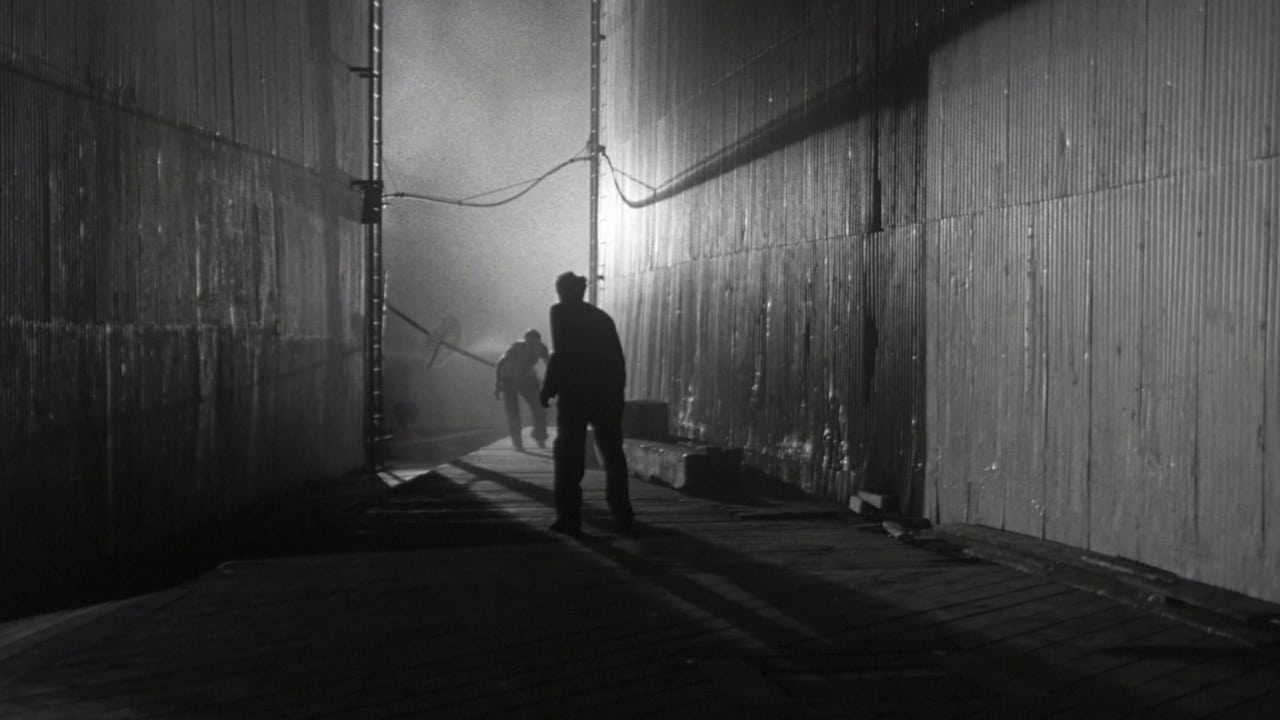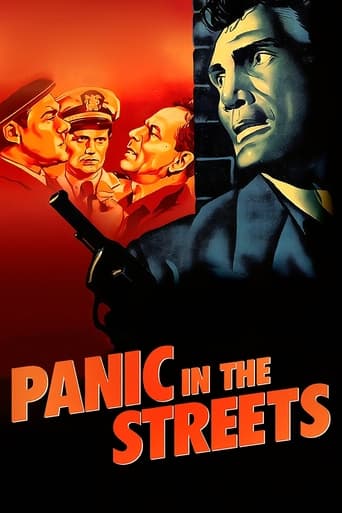

Highly Overrated But Still Good
... View MoreA-maz-ing
... View MoreAll that we are seeing on the screen is happening with real people, real action sequences in the background, forcing the eye to watch as if we were there.
... View MoreThere's no way I can possibly love it entirely but I just think its ridiculously bad, but enjoyable at the same time.
... View MoreDirector Elia Kazan really enjoyed directing the superb thriller, Panic in the Streets (1950) - "It's the first film I regard as really mine. Richard Murphy and I worked on the script every morning and re-wrote every scene to take advantage of the terrific color and photographic richness of New Orleans".But as with "Boomerang", Kazan told me that he was still unhappy with the camerawork: "Visually, it could have been much stronger." However, unlike his comments on many of the players in "Boomerang", Kazan had nothing but praise for his cast in Panic in the Streets: "Dick Widmark was a good friend of mine. I had directed him on the stage. He was typecast as vicious killers at this stage of his movie career, but I changed all that. He played a nice person in Panic, and he was like that in real life. "Then I cast Barbara Bel Geddes. Jack Palance I knew when he was Brando's understudy for A Streetcar Named Desire. This was his first film. I also cast Zero Mostel who had made only one movie before - way back in 1943."
... View MoreThis movie garnered an Oscar for Edna and Edward Anhalt's writing of the original story for a motion picture. And, WHAT a great idea for a story this is--even today. It was shot completely on location in what used to be a truly great and important gulf port city, New Orleans, Louisiana. This movie ingeniously teams up a crotchety, skeptical policeman (Paul Douglas) with a totally devoted doctor (Richard Widmark) from the US Public Health Service, a regular branch of the service that doesn't get enough attention for ITS service to our country. Here, we get to see Widmark as the good guy for a change. He is workaholic family man— struggling to make ends meet--who doesn't have enough time for wife (Barbara Bel Geddes) and his young son.As the movie opens, we see a group of gangsters playing cards in some cheap hotel room. Blackie (Jack Palance) is the boss of the gang, Fitch (Zero Mosel) is his go-for guy, and Poldi (Guy Thomajan) is another gang member. When Poldi's cousin wants to drop out of the card game because he is sick, Blackie doesn't want him to leave since he is too far ahead in the game. When he does leave, the gang chases him though the city and down to the train tracks where he is shot and left. The police discover his body the next day and have it taken to the Coroner's office for an autopsy.... We first get to know Lieutenant Commander Dr. Clinton Reed (Richard Widmark) and his family in the next scene. 'Clint' and his wife, Nancy (Barbara Bel Geddes), have money problems (and bill collectors) which worry them. But, right now, Clint is trying to take some time off from work to spend it his young son who he hardly ever sees because of his job...When the coroner's autopsy reveals that the man's body is loaded with pneumonic plague---a disease related to bubonic plague but more serious since it can be so easily contracted from sneezing, sputum, or simple contact--the Coroner's office calls in Clint to handle the possible effects of a ravaging plague epidemic. Clint immediately calls for help from the NOPD. He needs them to help quickly find, and contain, the source of the plague before it spreads.Clint is teamed with a cynical Police Captain, Tom Warren (Paul Douglas), who doesn't care much for doctors or Navy men. (In fact, though Clint's uniform may look like that of a Navy officer, the US Public Health Service and the Navy have nothing whatsoever to do with each other.) Tom and Clint soon learn to work together as they realize each other's roles in the almost impossible mission of finding where the dead man came from while keeping their search 'under wraps' to prevent any possible panic. Added to the difficulty of finding where the dead man came from is the fact that his body, and therefore the dead man's ID, was immediately incinerated to prevent contagion. Also, they have to work fast since the incubation period is only 48 hours.As Clint and Tom chase down clues, they are eventually led to a restaurant in a Greek neighborhood. They find out that the restaurant owner's wife had suddenly died of a high fever. This brings them closer to the plague's source than they had ever been; it brings them close to where Poldi in now lying sick in his mother's apartment. Poldi's mother had ordered a nurse, who had reported his symptoms to a local hospital and ordered an ambulance.On the other hand, when Blackie and Fitch find Poldi, they believe that he and his cousin had been into something with a VERY big payoff. (After all—in their minds--why else wold the whole police department be looking SO hard to find Poldi and his cousin?) Blackie assumes that Poldi's cousin must have been in on a huge drug haul and Poldi must know about it. They try to pump Poldi for information before he dies. But, he is too sick to tell them anything. As Blackie and Fitch try to carry Poldi out of his mother's upstairs apartment, they meet Clint and Tom on the steps, throw Poldi down the steps, and are chased by the police.The final running foot-chase sequence, with the police in hot pursuit of Blackie and Fitch, is one of the best of it kind in film noir! The foot-chase takes us to the docks and in the warehouses and back streets of New Orleans. The two gangsters are seen on the levees, structures, and substructures of the once-famous gulf port city.The noir shots of Blackie and Fitch (Palance and Mosel) running across structures, popping up and dropping down from one level of a coffee and banana warehouse to another is almost visually poetic. In fact, they remind us of rats crawling along beams, bridges and other structures (occasionally falling in the swampy water only to get up and run some more). The rat analogy reminds us of the plague that ships sometime bring into ports and refocuses us on WHY the two are being chased in the first place: to stop and control an possible plague epidemic. After Fitch has been shot dead, the final rat-plague analogy is brought home as we see Blackie climbing a fruit freighter's line. He falls to his death, not by a bullet from the police, but by the line's rat catcher.
... View MoreIn New Orleans, Blackie (Jack Palance) and his thugs attack and kill a sick man who walked out of his game after winning his money. The coroner finds something suspicious and calls in Dr. Clinton Reed (Richard Widmark). He declares it the extremely contagious pneumonic plague. He faces opposition as he tries to raise the alarm.This is a rough and meandering thriller. The most compelling thing about the movie is the title. It's a lot of cop and robber procedural. Jack Palance is a good ruffian when he's on the screen. I like the dark gritty opening. Richard Widmark is a solid tough guy. None of the other actors are quite as striking. I don't find the investigation that compelling. It would be better if lots of people start dropping dead. The real world locations are great but the movie isn't terribly thrilling.
... View MoreWith the Cold War kicking into gear, this movie – in a way, like the Body Snatchers movies that followed it – focuses on the chaos of panic, here brought about by a deadly disease, a plague. Tense and at times terrifying, Panic in the Streets is electric gold as far as the genre is concerned. It's tightly written, although viewed through the glass of 2013 a little simplistic at times (see below), and expertly acted.It all starts when a man is smuggled onto a boat that docks in New Orleans. The man then visits a poker game with his cousin and winds up winning a lot of money from a gangster named Blackie (Jack Palance, in his debut). When the man, rather than risk his winnings to give Blackie a chance to win them back, takes off, he's cornered by Blackie and his henchmen, then shot to death and dragged into the river, where he's discovered the next morning.But when the coroner examines the body, he finds something suspicious. Yes, a bullet ended the man's life, but he was already dying. Enter Health Inspector Clint Reed (Richard Widmark), who immediately recognizes the disease as pneumonic plague, which – and I don't know this to be scientific fact – is extremely contagious. Reed must find the man's cousin, the Patient Zero, before he can unwittingly pass the illness – which is fatal – along to the rest of the city, even the world.He's teamed up with crusty police chief Tom Warren (Paul Douglas), who's not sure the doctor's right but is smart enough to follow orders anyway, however reluctantly. It doesn't take long for him to be convinced that there is cause for panic and that the city as a whole must be quietly quarantined, if plausible.The chemistry between Douglas and Widmark drives the script. Palance is a terrific menace, as he would go on to be in countless movies. Zero Mostel is on hand as one of his henchmen; Barbara Bel Geddes plays Reed's wife. The men are in a race against time, figuring they have less than 48 hours to find their Patient Zero. Warren's police work and Douglas' medical knowledge help them retrace the smuggled man's footsteps and those of the newly infected as well.If I'm going to gripe about anything, it's the ease with which Reed eradicates the disease. What's that, you say? You may have encountered the sick man? Here, we'll inoculate you, all better. Not sure that's how inoculation works, really, but I'll suspend disbelief for this movie on the grounds that it was a lot of fun to watch.
... View More